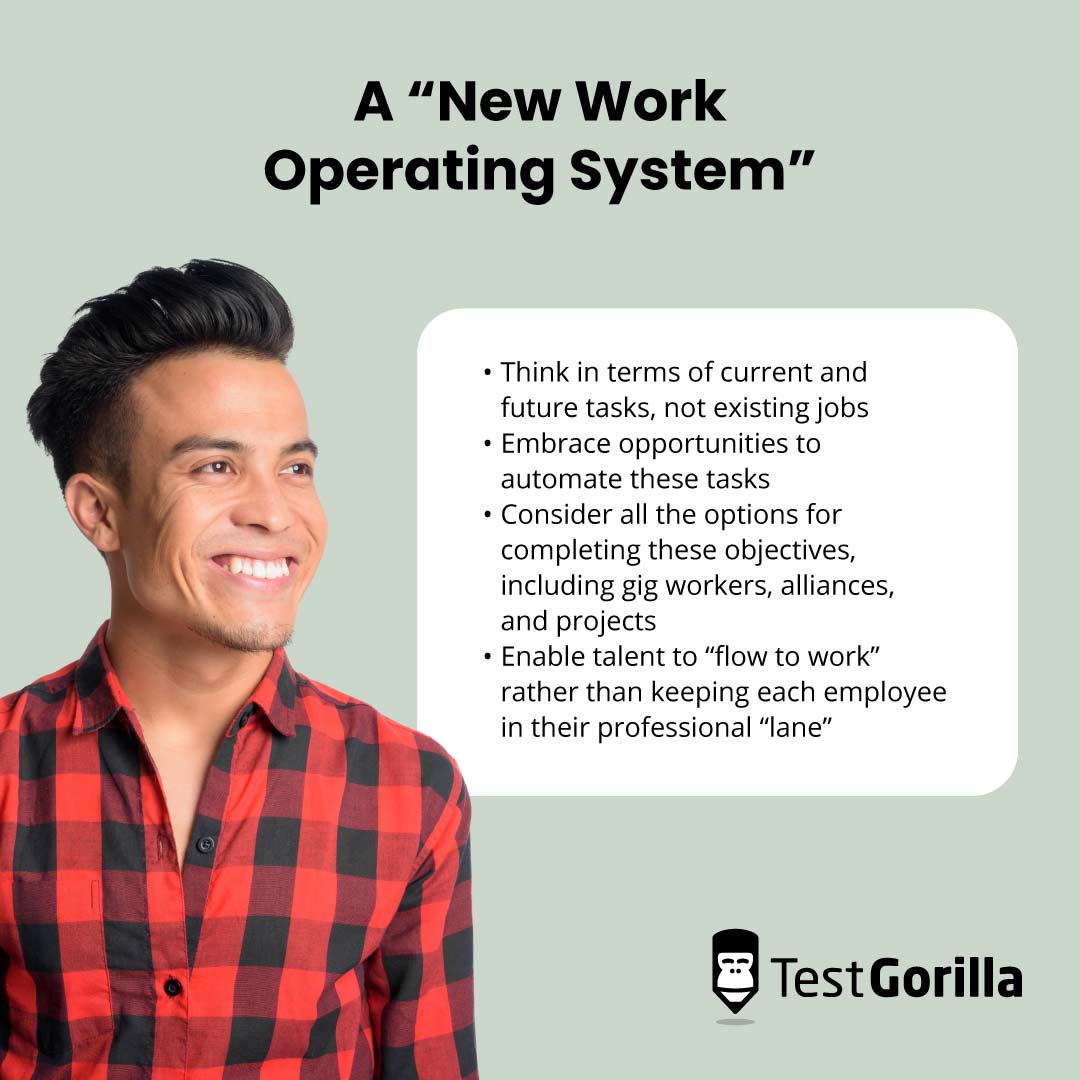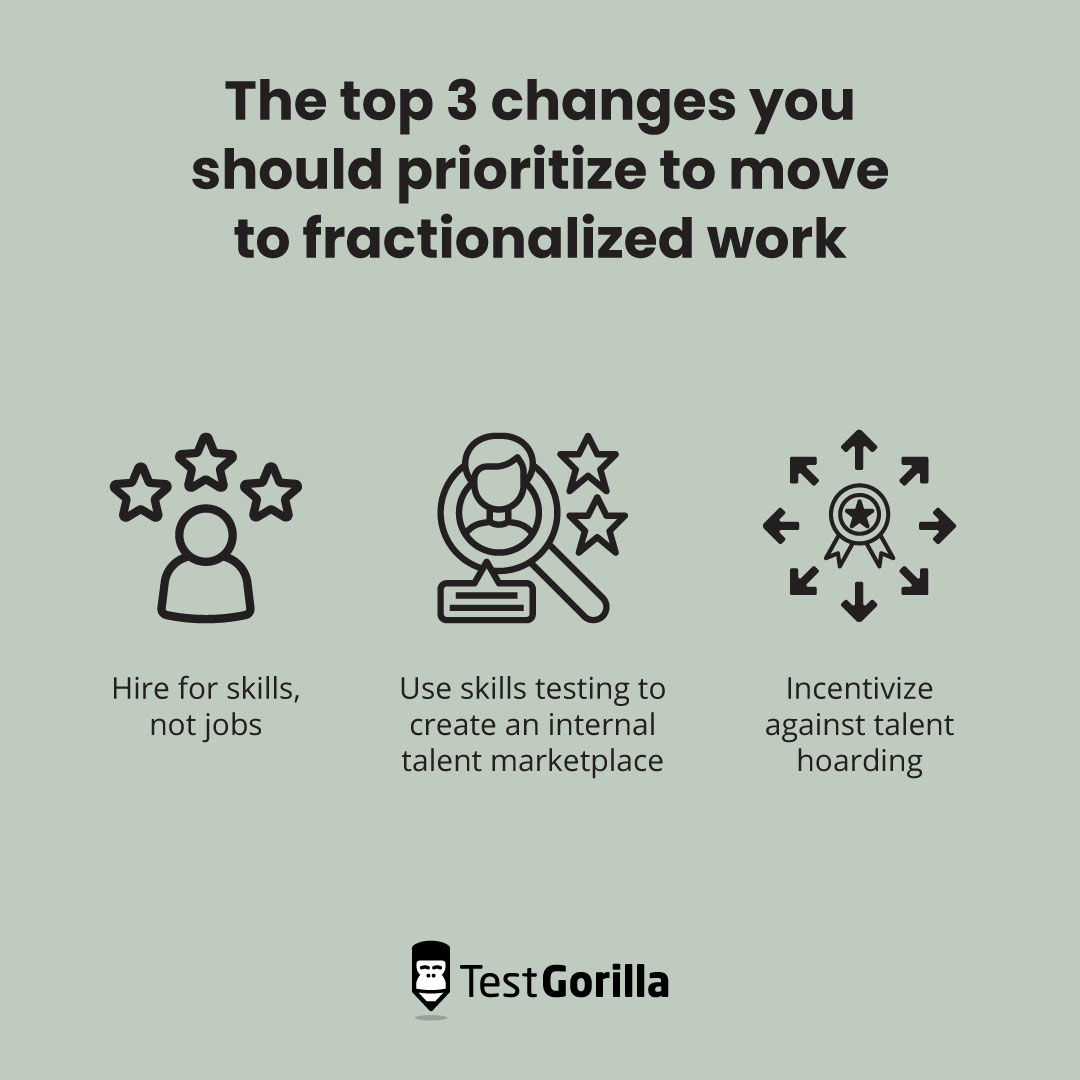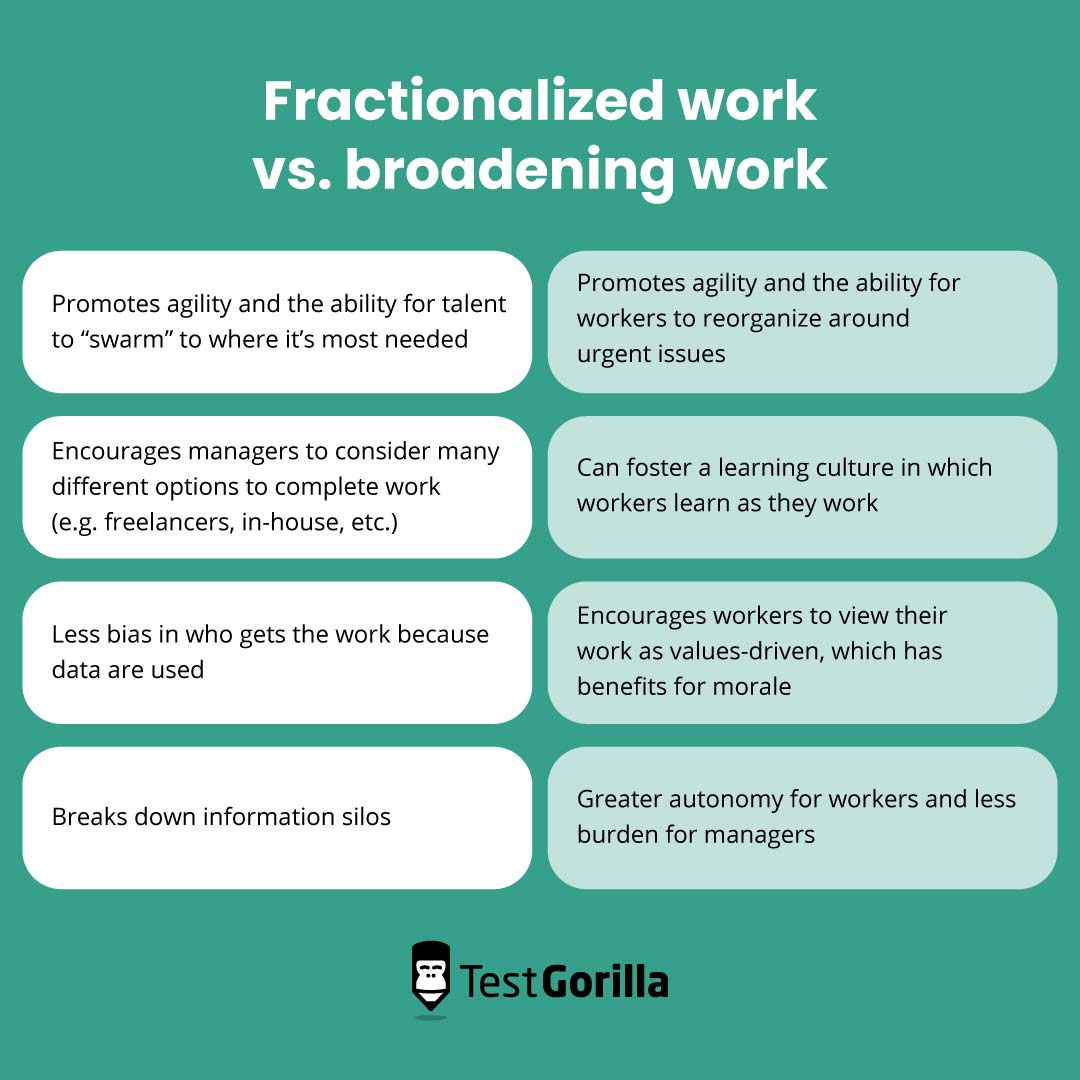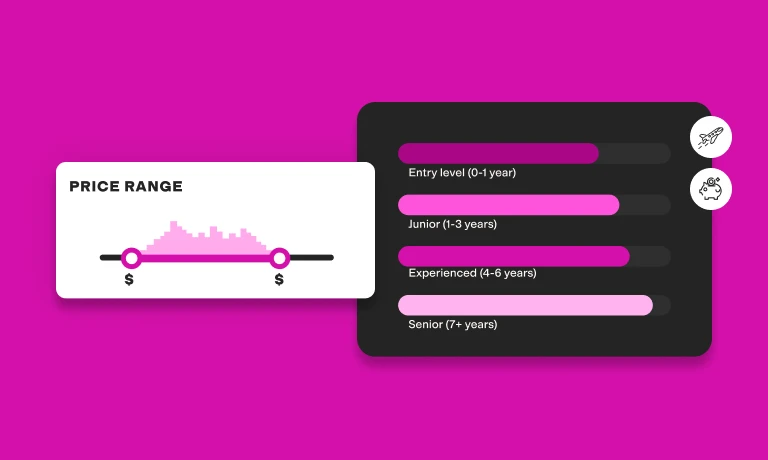Are we entering an era of work without jobs? What new work models mean for HR leaders
Job requirements, lists of tasks and responsibilities, and clear career trajectories for each job are the fundamentals of HR as we know them.
The idea that these things could no longer be fit for their purpose may feel like questioning whether the alphabet is fit for language. It seems foundational. Yet people established these norms at a very different time in the history of work.
Our lives have changed significantly in the past hundred years. The pace of change we are used to now would be enough to make heads spin back in the early 20th century.
It makes sense that the way we work needs to catch up.
Could there be a world of work without jobs?
In this blog, we explore what the world of work would look like without jobs as we know them. We examine the origin of the demand for work without jobs, the main models for implementing this, and how employers can get started.
Where does the demand for new work models come from?
Similar to the demand for skills-based hiring, the demand for new work models is a response to the massive shifts in our working lives over the past several decades.
There are two key components to this: the Fourth Industrial Revolution and the coronavirus pandemic.
The Fourth Industrial Revolution
In the late 20th century, Western society began to move from an industrial society to what Peter Drucker, an economist, calls a “knowledge economy,” in which information processing was the primary driver of growth and workers had to “think for a living.” [1]
Although the tasks we completed at work changed, the way we completed them didn’t keep pace.
Employees were still in standardized roles with rigid definitions of the responsibilities involved, and hiring efforts were focused on prior experience – with the new addition of four-year degree requirements.
This approach was a hangover of the previous industrial era and thus, not a good fit for the rapidly-changing digital work landscape.
Things began to change with the onset of the Fourth Industrial Revolution in the mid-2010s.
Employers started to break down jobs into their constituent tasks. Some of these tasks became the responsibility of automation software.
The remaining tasks were re-bundled into new but equally rigid roles, with employees having to upskill or reskill to meet the new requirements.
This phenomenon naturally created friction when attempting to adapt to the fluctuation in the labor market during the 2010s, which was soon to come to an unprecedented peak…
The Coronavirus pandemic
The onset of the Coronavirus pandemic and the start of lockdown restrictions around the world caused a seismic shift for businesses and their employees.
Governments rushed to support companies and prevent mass insolvency, and companies laid off more than 40 million workers across 37 economies.
Despite these tactics, many businesses and their employees still felt the toll. Unemployment rose higher in three months of the coronavirus pandemic than it did in two years of the Great Recession.
Organizations scrambled to survive by pushing most of their work online and reorganizing key teams, showing the need for organizations to increase their agility and become more adaptable.
Individuals’ roles became more fragmented, with employees taking on multiple new responsibilities to cover for colleagues who had been laid off or quit.
The situation persisted even after the end of the lockdown restrictions. Many workplaces embraced online working long-term by adopting a hybrid office model.
The result is that, even in roles that were once “traditional,” many people now find themselves in highly flexible employment in which they are not tied to one location or doing tasks related to only one team or function.
This effect could intensify over time. Fewer employees had clarity on what was expected of them in their jobs in 2022 than in 2021 (38% compared with 48%).
The pandemic restrictions not only mounted pressure on employees to diversify their work outside of their traditional roles, but they also increased pressure on employers.
After the severe labor losses prompted by the lockdowns, demand in many sectors returned to “business as usual” quickly, but many employers struggled to find skilled candidates for their open roles.
Employers are now operating in a candidate’s market, in which there are more open roles than skilled professionals willing to fill them.
As if that weren’t enough, the rate of change in digital work is only accelerating, and studies have shown that nearly 60% of the workforce already need new skills to do their jobs effectively.
Companies need a radical way to respond to this volatile landscape and create an agile workforce. Enter the concept of “work without jobs.”
What does “work without jobs” mean?
The term “work without jobs” was widely popularized by Ravin Jesuthasan, a consultant and author, and John Boudreau, a business school professor, in their eponymous 2021 book.
The book explores the authors’ belief that organizations today need to deconstruct jobs into tasks and workers into skills and capabilities in order to cope with the fluctuating landscape of digital work.
They describe a “New Work Operating System,” which dictates that employers:
Think in terms of current and future tasks, not existing jobs
Embrace opportunities to automate these tasks
Consider all the options for completing these objectives, including gig workers, alliances, and projects
Enable talent to “flow to work” rather than keeping each employee in their professional “lane”
For examples of this type of work in action, you need only look at the fluid work adopted by many organizations during the lockdowns, with skilled workers moving onto teams and projects that needed them more urgently.
Large consultancies are also a strong example of this work in action, with consultants often flowing between different projects based on their skills.
A Deloitte study released the same year echoed many of the sentiments of Jesuthasan and Boudreau’s book.
The authors identified two key branches of the “work without jobs” model: fractionalized work and broadened work.
The best insights on HR and recruitment, delivered to your inbox.
Biweekly updates. No spam. Unsubscribe any time.
New work model 1: Fractionalized work
The first work model outlined in the Deloitte paper was “fractionalized work.”
In other words, fractionalized work is the breakdown of existing jobs into skills and tasks described by Jesuthasan and Boudreau.
If organizations committed fully to this model, they would use internal talent marketplaces (more on these in a internal moment) to gain an overview of the skills available within their organization.
These marketplaces would be used alongside tools like Eightfold AI to identify where skills are most needed and redirect talent to cover those skills gaps.
Even a partially-fractionalized approach can have its benefits.
This job model could look like employees being enabled or even encouraged to take on skills-based tasks and projects outside of their current job in addition to their existing responsibilities.
Additional projects help employees diversify their skill sets, strengthen cross-functional collaboration, and improve organizational agility.
The pros and cons of a fractionalized approach
A fractionalized approach seems like a good entry point into “work without jobs,” but what are the practical pros and cons for employers? Here’s a breakdown:
The pros of a fractionalized approach | The cons of a fractionalized approach |
Promotes agility and the ability for talent to “swarm” to where it’s most needed Encourages managers to consider many different options to complete work (e.g. freelancers, in-house, etc.) Less bias in who gets the work because data are used When done right, it breaks down information silos | Complex to manage and reliant on the smooth running of complex tools Can hinder development by encouraging workers to specialize in certain skills they can apply to many projects Could lead to a competitive “hypermeritocracy” where employees compete based on the need to add value Limits workers’ autonomy when fully embraced because managers assign the tasks |
3 changes you can make to prepare for fractionalized work
Jobs as we know them are deeply embedded in business infrastructure.
To shift to a new approach, you should dig into these foundations and make some changes.
Here are the top three changes you should prioritize to move to fractionalized work.
1. Hire for skills, not jobs
It makes sense that, in an environment focused on skills rather than rigid roles and responsibilities, skills-based hiring would shine.
Industries already use skills-based hiring to prepare for the future of work, with skills testing replacing resumes in many organizations’ screening processes.
The main benefit of skills testing is that it enables recruiters to directly observe candidates’ skills instead of using proxies like university degrees and resumes.
With skills testing, they can hire for the potential presented by a candidate’s skill set rather than assumptions based on their past work experience.
When using skills-based hiring techniques to hire into a fractionalized workforce, recruiters can conduct a skills gap analysis of their current team and use it to identify and group the skills they need from a recruit.
Using skills assessments, recruiters can test for certain essential characteristics, such as problem-solving and comparing candidates’ performance on the identified key skills that are missing in their organization.
This technique enables recruiters to screen candidates from diverse skills, backgrounds, and demographics, such as those skilled through alternative routes, otherwise known as STARs.
Introducing people from diverse skills and backgrounds into the workforce facilitates a diversity of thought, but that isn’t the only type of diversity skills-based hiring promotes.
Skills-based hiring also has the benefit of leveling the playing field for candidates. Biases related to gender, race, or disabilities do not marginalize them.
Hiring this way reduces opportunities for unconscious bias at the screening stage and provides a basis of data for recruiters to refer to throughout interviews.
Reducing unconscious bias is more useful than you think. Research conducted at Yale University found that, even when interviewers received training on objective hiring, male and female scientists preferred to hire men.[2]
By contrast, a study of more than 2,000 successful job applicants found that using a skills-based hiring process increased the number of women hired into senior roles by nearly 70%.
2. Use skills testing to create an internal talent marketplace
Along with using skills testing to bring new skills into the fold, you can also use it to manage those skills once recruits enter your workforce.
The best way to do this is with an internal talent marketplace.
Traditionally, companies have used this HR software to show employees the potential roles available to them with their current skill set and avenues for development and promotion.
In a fractionalized workforce, this role becomes more complex and granular as the focus shifts to objectives and projects rather than open vacancies and career trajectories.
In the short term, using an internal talent marketplace for fractionalized work helps you promote internal mobility, which has benefits for your workforce.
Employees who move into new roles with their current employer are three times more likely to be engaged than their colleagues who don’t.[3]
In the long term, it is easier to shift the focus to skills across roles and redeploy employees into teams and departments where their skills are most needed.
Even if you think the fractionalized future is a long way off for your organization, this is a good place to start because it still applies to non-fractionalized work.
Begin by plugging the skills test results from your new employees into your internal talent marketplace and using it to create short-term interdisciplinary task forces focusing on pressing business challenges.
Then expand the software’s uses over time.
3. Incentivize against talent hoarding
One of the biggest barriers employers need to break down to embrace fractionalized working is the talent hoarding that occurs in many organizations.
Talent hoarding refers to when managers intentionally keep skilled individuals on their team despite the existence of growth opportunities for those individuals elsewhere.
Studies show that more than half of companies work in silos, with each function making decisions about which skills are the most important.[4]
Moreover, 70% of talent acquisition experts say that the largest barrier to internal mobility is managers not wanting to let good talent leave their team.[5]
Hoarding is not only harmful to individual employees’ growth but also to the growth of your organization. Breaking it down is essential to pave the way for fully fractionalized working.
To do this, incentivize managers to participate in information sharing.
Incentives include redefining the managerial role as one that offers a “base” to deploy talented employees to other projects, but to which they return for development support and performance management.
You can also include data about how many cross-functional projects the direct reports of a manager participated in and worked on in yearly performance reviews.
New work model 2: Broadening work
Fractionalizing work is about boiling down business objectives into their component tasks and skills, with managers “swarming” these skills around urgent objectives.
Broadening work is pretty much the opposite.
In broadened work, workers unite around high-level tasks and problems and have a large amount of autonomy about how they apply their skill sets to these objectives.
This outcome-focused approach prioritizes creativity and agility. The outcomes could be individual goals established by team members for their development.
These goals could be very specific or very high-level.
For instance, a worker at a sustainable coffee company can define their objective as “Raising the bar for sustainability in the coffee industry by making delicious, carbon-neutral coffee accessible to everyone.”
An example of this in a partially-broadened workforce is Google’s “20% time”: an initiative in which Google engineers are allowed to spend 20% of their time focusing on their own projects, as long as these align with their central passion and purpose.
Allowing time for the employees’ personal projects emphasizes overall objectives and could have benefits in attracting candidates.
It places values front and center, and we know that job seekers rank company culture highly when appraising a new role – 86% say it is important to them.
The high-level tasks that direct employees’ work can also be established by their team or by the top management.
It could even be more free-flowing than that. At Morning Star, a tomato processor, no one has a job title. Only two layers of management exist in the organization: the president and everyone else.
Instead of being directed by managers, employees collaborate with their colleagues to agree on roles and responsibilities in response to business objectives and even to approve sales. It’s a self-regulating ecosystem.[6]
The pros and cons of broadening work
Broadening work certainly seems like a radical approach. It could mean getting radical rewards, too.
To understand if it’s right for your business, look at the pros and cons:
The pros of a broadened approach | The cons of a broadened approach |
Like fractionalized work, it promotes agility and the ability for workers to reorganize around urgent issues When done correctly, it can foster a learning culture in which workers learn as they work Encourages workers to view their work as values-driven, which has benefits for morale Greater autonomy for workers and less burden for managers | Requires substantial work on company culture and a strong basis of mission-driven work Could be more difficult to ensure that the right skills are in the organization at a given time and to navigate skills shortages Could be more difficult for employees to move around because it relies on them autonomously breaking out of their comfortable networks |
3 changes you can make to prepare for broadened work
All three strategies we outlined for fractionalized work have a place in the push toward broadened work.
However, there are a few specific things to consider if broadening work is your overall goal.
1. Test for a broad range of skills when hiring
The idea of a broadened work model could strike fear into the heart of recruiters, and we understand why.
Broadening work is about understanding that any mix of skills can make a difference with enough support.
Looking for someone who can help you solve a problem or pursue a broad outcome sounds great – but how can you accurately predict performance unless you’re being prescriptive about the skills they can use to do that?
First, we would recommend that organizations considering a broadened work model conduct many of the same skills testing processes as fractionalized organizations, including:
Using skills testing to screen and hire candidates
Plugging skills assessment results into a skills inventory or internal talent marketplace
Using this software to identify skills gaps and surface development opportunities for employees
For example, you can look at your internal talent marketplace and realize you have a dearth of project management skills in your organization.
Rather than hiring specifically for a project manager, you can instead test candidates primarily in project management skills, but emphasize in the job ad that you’re open to diverse backgrounds as long as they are motivated by your mission.
You can then use a wide range of additional questions to gain a broad view of a candidate’s skill set, prioritizing factors like:
Motivation: whether the candidate has the same vision for the company’s future
Cognitive skills like problem-solving and self-efficacy
Culture add: whether the candidate shares the values of your organization and adds something new to your skills mix
Strong scores in multiple skill areas rather than a high level of specialism in just one
Skills that are adjacent to in-demand or hard-to-find technical skills that you can use training to develop
The wide range of skills involved enables you to identify the “multipotentialites”: employees who can fill the skills gaps and also have the flexibility to work consistently cross-functionally and align themselves with your organization’s values and vision.
2. Embrace skills-based learning
One of the great things about broadened work is that it offers ample opportunities for employees to learn through skills-based learning.
By encouraging employees to organize their work around the company’s overarching goals, broadened work encourages individuals to evaluate their skill sets and identify the skills they’re missing to do the work they want.
Armed with this knowledge and well-designed skills-based development initiatives, they can pursue skills growth and tackle innovation.
Facilitating this learning process is necessary to take full advantage of the flexibility and company culture benefits of broadened work.
Indeed, Harvard researchers recommend upskilling as a direct tactic to improve organizational agility, and other studies have shown that 93% of chief executive officers who use upskilling programs see benefits, including:
Increased productivity
Better retention
Improved talent acquisition
More resilience among workers
This benefit is why broadened work appeals to some employers more than fractionalized work. The latter could encourage employees to hyper-specialize as they delve repeatedly into different projects based on their existing skills.
3. Create a psychologically safe workplace and culture
Finally, you can’t have a broadened workplace without creating a culture of psychological safety, in which employees feel heard and supported to make decisions about their work.
Some of the principles of psychological safety, like workload management, could seem to be at odds with the principle of autonomy that governs broadened work, but they can be adapted to fit the broadened work framework.
In the case of workplace management, you could use peer-to-peer support and accountability networks to encourage your employees to monitor themselves and one another for burnout.
Employee resource groups are a great example of this process in action and can be deployed even in a remote workplace.
Safety promotes a positive company culture and is very likely to improve retention because the principles of psychological safety address many of the top reasons why employees quit their jobs, including:
A noninclusive community
Unreliable and unsupportive colleagues
Unsustainable work expectations
Assess the skills of your workforce to future-proof your business against disruption
Fractionalized and broadened work could seem extreme, but when you scratch beneath the surface, they have the potential to make your organization more flexible and resilient.
The first step to either approach to work without jobs is to embrace skills-based hiring and development programs – perhaps especially for the leaders who can steer your business through times of change.
If you’re looking for leaders who can take the helm in these times of upheaval, read our guide to agile leadership and how to hire for it.
If you’re already deep in the hiring process and need to find candidates able to tackle complex challenges, use our Problem Solving test to hire the best.
Sources
Drucker, Peter F. (September-October 1992). “The New Society of Organizations”. Harvard Business Review. Retrieved May 03, 2023. https://hbr.org/1992/09/the-new-society-of-organizations
Agarwal, Pragya. (December 3, 2018). “Unconscious Bias: How It Affects Us More Than We Know”. Forbes. Retrieved May 03, 2023. https://www.forbes.com/sites/pragyaagarwaleurope/2018/12/03/unconscious-bias-how-it-affects-us-more-than-we-know/?sh=3333fe6e13e7
“Skill Building in the New World of Work”. (2021). LinkedIn Learning. Retrieved May 03, 2023. https://learning.linkedin.com/content/dam/me/business/en-us/amp/learning-solutions/images/wlr21/pdf/LinkedIn-Learning\_Workplace-Learning-Report-2021-EN-1.pdf
Giacoman, Andrew; Ribiero, Frank. (2016). “Dealing with market disruption: Seven strategies for breaking down silos”. PwC. Retrieved May 03, 2023. https://www.strategyand.pwc.com/gx/en/insights/2016/dealing-market-disruption/dealing-with-market-disruption.pdf
“2020 Global Talent Trends”. (2020). LinkedIn Talent Solutions. Retrieved May 03, 2023. https://business.linkedin.com/content/dam/me/business/en-us/talent-solutions/resources/pdfs/linkedin-2020-global-talent-trends-report.pdf
Minnaar, Joost. (November, 2016). “Morning Star’s Success Story: No Bosses, No Titles, No Structural Hierarchy”. Corporate Rebels. Retrieved May 4, 2023.
You've scrolled this far
Why not try TestGorilla for free, and see what happens when you put skills first.





















